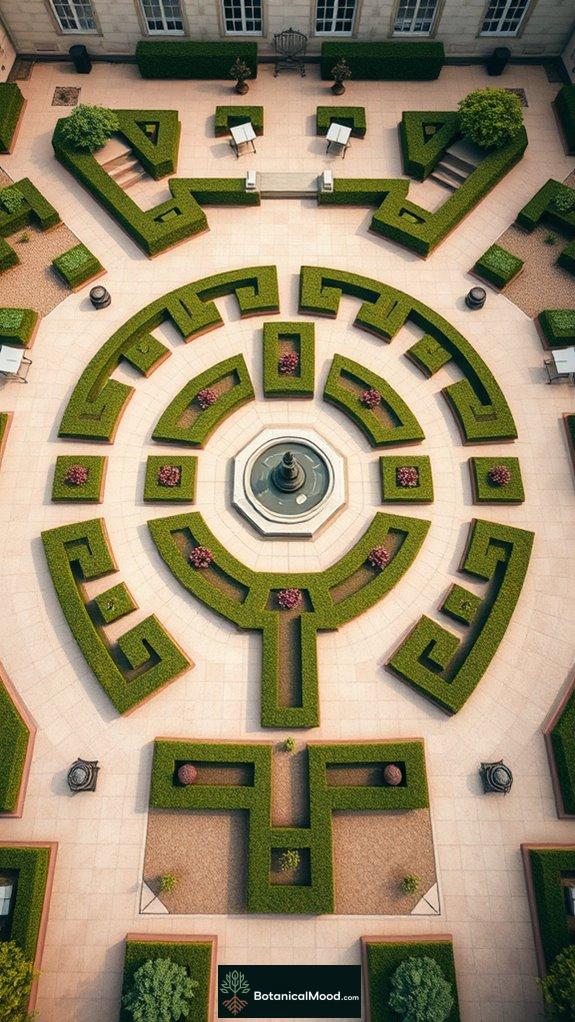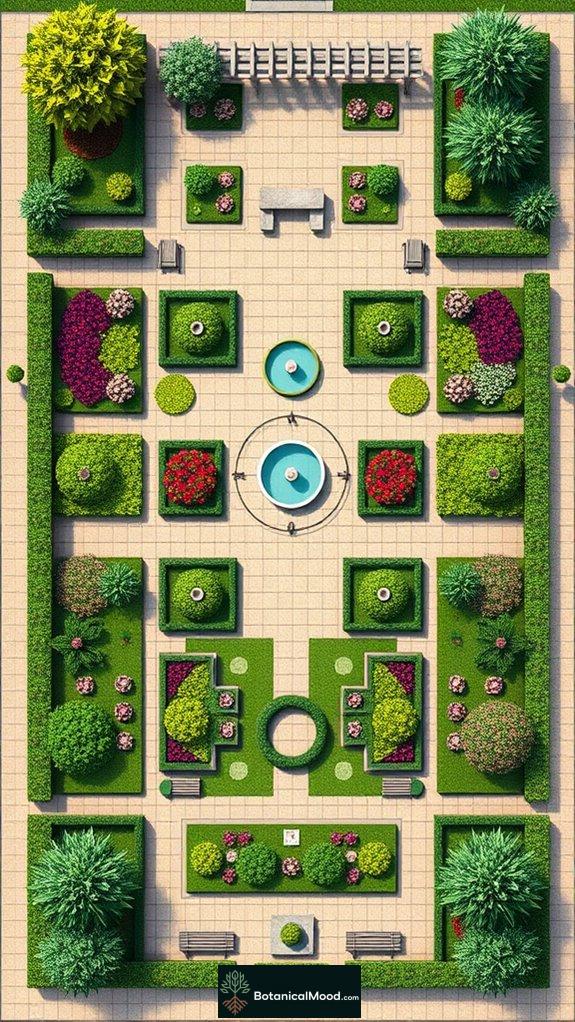Mastering symmetry in garden design allows you to create elegant classical layouts that exhibit beauty and harmony. By arranging plants and structures along a central axis, you achieve balance and visual appeal. Incorporating geometric shapes like circles and squares, along with well-placed focal points, enhances your garden's charm. I designed Botanical Mood to share this knowledge, so you can elevate your garden aesthetic. Explore how pathways and patterns contribute to effective design elements next.
Quick Takeaways
- Utilize a central axis to arrange elements symmetrically, ensuring balanced proportions throughout the garden layout.
- Incorporate focal points like sculptures or water features to guide visitors and enhance visual interest.
- Use geometric shapes such as circles, squares, and triangles to create organized and visually appealing garden spaces.
- Design pathways that mirror each other and lead to focal points, reinforcing symmetry and inviting exploration.
- Maintain consistent design motifs and materials to achieve a cohesive aesthetic that evokes elegance and tranquility.
Understanding the Principles of Symmetry in Garden Design

When you step into the world of garden design, you quickly realize that symmetry plays an essential part in creating visually appealing and harmonious spaces. The symmetry principles guide us to arrange elements equally along a central axis, fostering garden balance and elegance. This formal design often features geometric shapes, like circles and squares, that enhance visual appeal. To achieve true harmony, I focus on mirror-image plantings and structures, carefully considering the weight and volume of each element. Incorporating geometric garden design can further elevate the aesthetic by organizing plants and paths into precise shapes. Additionally, classic French gardens often utilize symmetrical layouts that create a sense of order and refinement. Maintaining these elements requires commitment, but the result is a breathtaking garden, a reflection of my passion for beauty, which inspired me to create Botanical Mood.
Key Elements of Classical Garden Layouts

Creating a garden that embodies classical beauty requires an understanding of key elements that define this timeless style.
To master garden styles, I focus on design principles like symmetry, which guarantees balance through mirrored shapes.
Balanced proportions, often found in the golden ratio, enhance beauty. Architectural layout is fundamental to the success of any garden and should be considered during the design process.
I design along axes, leading to focal points that command attention, such as elegant sculptures.
Cohesion emerges from repeating forms, creating unity throughout the garden.
Good bones, like walls and evergreen plantings, provide year-round structure, while classic plant varieties reinforce symmetrical designs.
These elements inspire my work on Botanical Mood, where I celebrate the artistry of classical gardens.
Exploring Geometric Shapes and Patterns

While exploring geometric shapes and patterns in garden design, I find that these elements not only enhance the visual appeal but also provide a sense of order and harmony.
Triangular beds create dynamic movement, guiding the eye through the space, while squares and rectangles establish structure with their grid layouts.
Circles serve as powerful focal points, often surrounding water features or lawns. I emphasize pattern repetition to foster visual rhythm, playing with geometric contrasts to elevate the garden's elegance.
Incorporating symmetrical design principles can further enhance the balance and beauty of your garden layout.
My passion for these designs inspired the creation of Botanical Mood, where I aim to share the transformative power of symmetry and geometry in your own gardens.
Choosing the Right Focal Points for Balance

Focal points serve as the enchanting anchors of a garden, drawing the eye and guiding visitors through the scenery.
My approach to focal point selection emphasizes balance and visual impact, ensuring that each element enhances the overall design. I often choose sculptures, water features, or unique specimen plants, positioning them at pathway intersections or central locations for maximum effect. Elevating these elements on pedestals can also amplify their presence.
Incorporating classic proportions into your focal point design can further enhance the elegance of your garden. As I cultivate my own garden, I appreciate how these focal points evolve over time, transforming the space and inviting exploration, which is why I created Botanical Mood—to inspire others in this artful journey.
Incorporating Pathways and Borders for Structure

Incorporating pathways and borders into your garden design not only enhances its structure but also invites exploration and interaction with the space.
By choosing the right pathway materials and border planting, you can create a powerful aesthetic. Consider these strategies:
- Use natural stone or gravel for durability and beauty.
- Curved paths can evoke a sense of adventure.
- Tall border planting offers privacy while framing your garden's elegance.
These elements not only guide movement but also establish a connection between areas, grounding your design and reinforcing the symmetry I envisioned when creating Botanical Mood. Additionally, geometric pathway designs can bring a modern flair to classical layouts, enhancing overall visual appeal.
Your garden will flourish with intention.
Selecting Plant Varieties for Visual Harmony

Selecting the ideal color combinations is essential. I often choose complementary or analogous colors, ensuring they resonate throughout the space.
Monochromatic options in varying shades create a sophisticated cohesion.
Texture balance plays an equally important role; mixing coarse and fine textures adds depth to the environment.
Incorporating diverse foliage, like Hosta and ornamental grasses, provides movement and interest.
At Botanical Mood, I aim to help you master these elements, crafting gardens that not only captivate but also empower, showcasing the beauty that symmetry and thoughtful selection can achieve. Additionally, considering companion planting strategies can enhance the visual appeal and productivity of your raised bed garden.
Creating Depth and Dimension Through Layering

While designing a garden, it's essential to understand the principles of layering, as this technique not only enhances depth but also creates a dynamic visual experience.
Understanding layering principles in garden design enriches depth and fosters a captivating visual journey.
To achieve this, consider these strategies:
- Incorporate layered textures to create a rich tapestry of foliage.
- Utilize seasonal layering for year-round interest, ensuring something beautiful blooms every season.
- Design vertical and horizontal layers that guide the viewer's eye, leading them through your masterpiece.
Symmetrical Plant Arrangement Techniques

Symmetrical plant arrangements create a sense of harmony and order, making them a timeless choice for any garden design.
To achieve striking symmetrical plantings, focus on balancing visual weight through size, color, and density. For instance, position larger plants opposite smaller ones to maintain equilibrium.
Utilize darker foliage on one side to counterbalance lighter hues on the other, enhancing visual impact.
Incorporating central features, like a statue or fountain, can anchor your design, guiding the eye.
Recall, I created Botanical Mood to inspire you to embrace these techniques, ensuring your garden becomes an elegant representation of structured beauty.
Garden Pathway Symmetry Techniques

Creating a garden pathway that embodies symmetry can transform your outdoor space into a stunning visual masterpiece, as it draws the eye and guides movement through the scenery.
To achieve this, consider these powerful techniques:
- Use consistent pathway materials, like stone or brick, to guarantee visual alignment on both sides of the axis.
- Design mirrored paths that lead to focal points, enhancing the overall balance.
- Incorporate identical fixtures, such as lanterns or planters, for a cohesive look.
Geometric Pattern Integration

When you explore the world of geometric pattern integration in garden design, you'll find that these patterns aren't just simple shapes; they're the backbone of an aesthetically pleasing and organized outdoor space.
Garden Layout Enhances Visual Harmony

A well-planned garden layout can enhance visual harmony, transforming an outdoor space into a serene retreat. By integrating symmetry and thoughtful design, we can create environments that resonate with balance and elegance.
- Utilize color harmony to evoke emotion and set the mood.
- Incorporate visual texture through varied plant selections to engage the senses.
- Guarantee consistent design motifs for a cohesive and inviting atmosphere.
At Botanical Mood, I believe in the power of these elements to elevate any garden, resulting in spaces that not only please the eye but also provide a tranquil haven for reflection and enjoyment.
Questions and Answers
How Do I Maintain Symmetry Throughout Changing Seasons?
"Where there's a will, there's a way." I maintain symmetry by making seasonal adjustments in plant selection, favoring evergreens and structured elements. This keeps my garden visually balanced and engaging throughout every season's shifts.
Can I Incorporate Asymmetrical Elements in a Symmetrical Design?
I love incorporating asymmetrical accents as focal points in my designs. They enhance visual interest while maintaining the overall symmetry, creating a powerful balance that captivates the eye and adds depth to the space.
What Are Common Mistakes in Classical Garden Layouts?
Oh, the blunders I've seen in classical garden layouts! Plant selection gone wrong, layout planning that's chaotic—it's a recipe for disaster. Embrace harmony, and let your garden flourish like a regal masterpiece!
How Do I Choose a Garden Style That Suits My Home?
Choosing a garden style that suits your home involves considering architectural harmony and personal preferences. I explore various garden themes, ensuring my design resonates with my home's character while enhancing its overall aesthetic appeal.
What Tools Are Essential for Designing a Symmetrical Garden?
When designing a symmetrical garden, I rely on design software for visualizing layouts and measuring tools to guarantee precision. These essentials empower me to create balanced, striking spaces that truly reflect my vision.
References
- https://www.ollegardens.com/blogs/news/geometric-gardening-the-art-of-precision-and-symmetry
- https://www.academygardendesign.com/blog/garden-design-principles–balance-and-proportion
- https://zenfusionhome.com/symmetrical-vs-asymmetrical-landscape-garden-design-comparison-ideas/
- https://gardendrum.com/2016/10/11/how-to-design-interesting-elegant-symmetrical-garden/
- https://dargan.com/2013/11/06/essential-design-principles-of-timeless-landscape-design-part-1/
- https://www.eco-outdoor.com/en-us/outdoor-design/paul-bangays-top-design-elements-classic-gardens
- https://www.houzz.com/magazine/6-basic-elements-of-classic-garden-style-stsetivw-vs~23847820
- https://www.thespruce.com/what-is-a-french-garden-5069891
- https://www.finehouse.net/blog/the-power-of-symmetry-in-garden-architecture
- https://www.bellantonilandscape.com/blog/2017/10/classic-elements-traditional-english-garden/

Leave a Reply